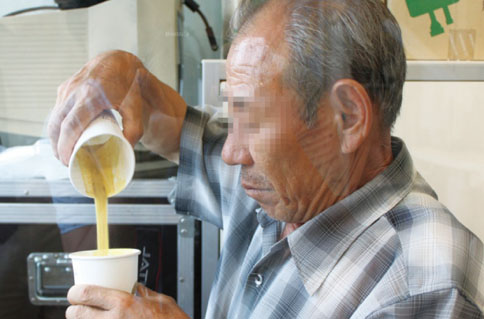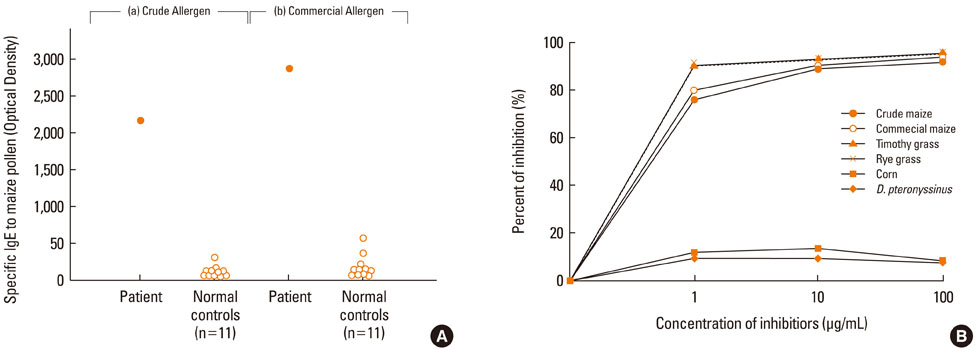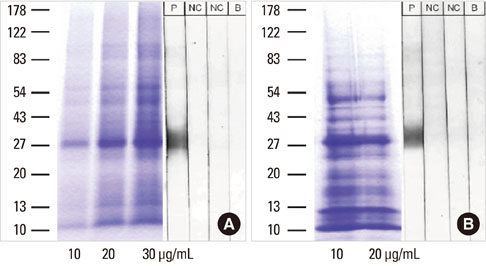Allergy Asthma Immunol Res.
2012 Jan;4(1):49-51. 10.4168/aair.2012.4.1.49.
A Case of Occupational Rhinitis Induced by Maize Pollen Exposure in a Farmer: Detection of IgE-Binding Components
- Affiliations
-
- 1Department of Internal Medicine, Yonsei University Wonju College of Medicine, Wonju, Korea. sanghakim@yonsei.ac.kr
- 2Department of Allergy and Rheumatology, Ajou University School of Medicine, Suwon, Korea.
- KMID: 2130379
- DOI: http://doi.org/10.4168/aair.2012.4.1.49
Abstract
- Corn is a major staple food, along with rice and wheat, in many parts of the world. There are several reports of hypersensitivity to maize pollen. However, cases of occupational allergic rhinitis induced by inhalation of maize pollen are very rare. We herein report the case of a 67-year-old male with occupational rhinitis caused by occupational exposure to maize pollen in a cornfield. He showed positive responses to maize pollen, as well as grass pollens, in skin prick tests. A high level of serum immunoglobulin E (IgE) specific to maize pollen extracts was detected by an enzyme-linked immunosorbent assay (ELISA). Laboratory tests showed a high serum level of total IgE (724 kU/L) and a high level of IgE specific to maize pollen (8.32 kU/L) using the Immuno-CAP system. Occupational rhinitis was confirmed by a nasal provocation test with maize pollen extracts. IgE ELISA inhibition tests showed antibody cross-reactivity between maize pollen and grass pollen extracts. IgE immunoblotting using maize pollen extracts demonstrated a 27 kDa IgE-binding component. These findings suggest that maize pollen can induce IgE-mediated occupational rhinitis in exposed workers.
MeSH Terms
Figure
Cited by 1 articles
-
Occupational Rhinoconjunctivitis due to Maize in a Snack Processor: A Cross-Reactivity Study Between Lipid Transfer Proteins From Different Cereals and Peach
Daiana Guillen, Pilar Barranco, Arantxa Palacín, Santiago Quirce
Allergy Asthma Immunol Res. 2014;6(5):470-473. doi: 10.4168/aair.2014.6.5.470.
Reference
-
1. Goss JA. Development, physiology, and biochemistry of corn and wheat pollen. Bot Rev. 1968. 34:333–359.2. Aylor DE. Settling speed of corn (Zea mays) pollen. J Aerosol Sci. 2002. 33:1601–1607.3. Pleasants JM, Hellmich RL, Dively GP, Sears MK, Stanley-Horn DE, Mattila HR, Foster JE, Clark P, Jones GD. Corn pollen deposition on milkweeds in and near cornfields. Proc Natl Acad Sci U S A. 2001. 98:11919–11924.4. Gonzalo-Garijo MA, Pérez-Calderón R, Muñoz-Rodríguez A, Tormo-Molina R, Silva-Palacios I. Hypersensitivity to maize pollen. Allergy. 2004. 59:365.5. Freeman GL. Oral corn pollen hypersensitivity in Arizona Native Americans: some sociologic aspects of allergy practice. Ann Allergy. 1994. 72:415–417.6. Kim JH, Kim JE, Choi GS, Hwang EK, An S, Ye YM, Park HS. A case of occupational rhinitis caused by rice powder in the grain industry. Allergy Asthma Immunol Res. 2010. 2:141–143.7. Palomares O, Fernández-Nieto M, Villalba M, Rodríguez R, Cuesta-Herranz J. Occupational allergy in a researcher due to Ole e 9, an allergenic 1,3-beta-glucanase from olive pollen. Allergy. 2008. 63:784–785.8. Atis S, Tutluoglu B, Sahin K, Yaman M, Küçükusta AR, Oktay I. Sensitization to sunflower pollen and lung functions in sunflower processing workers. Allergy. 2002. 57:35–39.9. Barraclough R, Bradshaw L, Barber C, Curran A, Fishwick D. Latent period for symptomatic sensitization in bakeries. Occup Med (Lond). 2005. 55:580.10. Chan-Yeung M. Occupational asthma. Chest. 1990. 98:148S–161S.11. Malo JL, Lemière C, Desjardins A, Cartier A. Prevalence and intensity of rhinoconjunctivitis in subjects with occupational asthma. Eur Respir J. 1997. 10:1513–1515.12. Stewart GA. Adkinson NF, Bochner BS, Busse WW, Holgate ST, Lemanske RF, Simons FE, editors. The structure and function of allergens. Middleton's allergy: principles & practice. 2009. Philadelphia: Elsevier;569–608.
- Full Text Links
- Actions
-
Cited
- CITED
-
- Close
- Share
- Similar articles
-
- A Case of Occupational Rhinitis Caused by Rice Powder in the Grain Industry
- Identification of immunoglobulin E binding components of two major tree pollens, birch and alder
- Occupational Rhinoconjunctivitis due to Maize in a Snack Processor: A Cross-Reactivity Study Between Lipid Transfer Proteins From Different Cereals and Peach
- Identification of IgE binding components of two major weed pollens, ragweed and mugwort
- Occupational Asthma and Rhinitis Induced by a Herbal Medicine, Wonji (Polygala tenuifolia)




